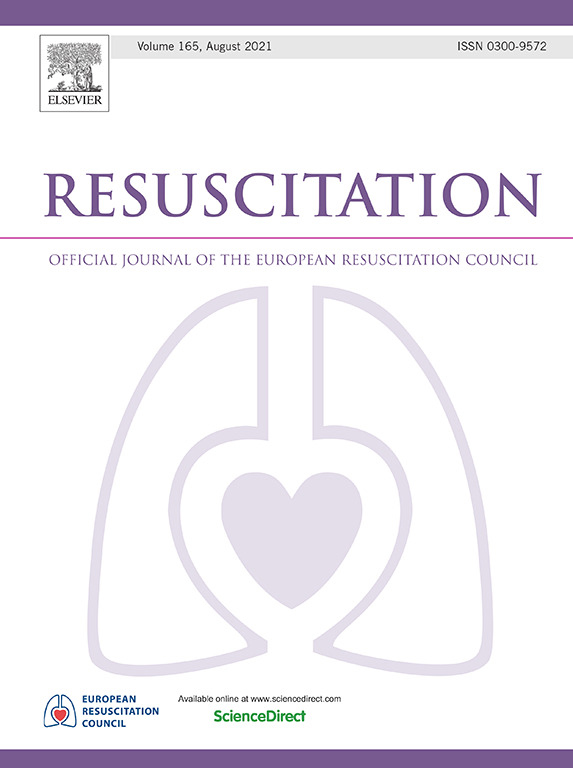Automated cardiac arrest detection and emergency service alerting using device-independent smartwatch technology: proof-of-principle
IF 4.6
1区 医学
Q1 CRITICAL CARE MEDICINE
引用次数: 0
Abstract
Introduction
Out-of-hospital cardiac arrest (OHCA) is a leading cause of mortality. Automated detection could improve survival by reducing delays in first responder activation. This study provides proof-of-principle for a device-independent technology that can (A) distinguish presence versus absence of spontaneous circulation, and (B) reliably alert emergency medical services (EMS).
Methods
Circulatory arrest data were collected from three groups: (1) volunteers undergoing temporarily restricted blood flow to the arm using a cuff, (2) patients undergoing cardioplegic cardiac arrest for heart surgery, and (3) domestic swine, slaughtered in food industry. Data were collected using Samsung Watch5 and Watch5 Pro. An algorithm was developed to analyze photoplethysmography signals and detect circulatory arrest.
Emergency response was tested via the Dutch community first responder network HartslagNu, using their test environment to activate test responders and EMS.
Results
Nineteen participants were analyzed. Across all three groups, 28 of 31 circulatory arrests were correctly identified, sensitivity 90.3% (95% CI: 74.2%–98.0%), and hour-level specificity was 94.1% (95% CI: 71.3%–99.9%). Triggering a circulatory arrest consistently resulted in an audiovisual smartwatch alarm and an instantaneous alert to the virtual EMS at the HartslagNu test server.
Conclusion
This study demonstrates the feasibility of detecting circulatory arrest using commercially available smartwatch sensors, achieving high sensitivity and specificity. Additionally, we integrated an automated alerting system with emergency networks to notify first responders.
While this technology shows promise to improve survival, higher specificity is needed to prevent overburdening EMS. Future research should focus on real-world validation using actual cardiac arrest data.
使用独立于设备的智能手表技术的自动心脏骤停检测和紧急服务警报:原理验证。
院外心脏骤停(OHCA)是导致死亡的主要原因。自动检测可以通过减少第一响应者激活的延迟来提高生存率。这项研究为一种独立于设备的技术提供了原理证明,该技术可以(a)区分有无自发循环,(B)可靠地向紧急医疗服务(EMS)发出警报。方法:收集三组血液循环停止数据:(1)使用袖带暂时限制血液流向手臂的志愿者,(2)因心脏手术而心脏骤停的患者,(3)在食品工业中屠宰的家猪。使用三星Watch5和Watch5 Pro收集数据。开发了一种算法来分析光容积脉搏波信号并检测循环骤停。通过荷兰社区第一响应者网络HartslagNu对应急响应进行了测试,使用他们的测试环境来激活测试响应者和EMS。结果:对19名参与者进行了分析。在所有三组中,31例循环骤停中有28例被正确识别,灵敏度为90.3% (95% CI: 74.2% - 98.0%),小时水平特异性为94.1% (95% CI: 71.3% - 99.9%)。持续触发循环停止会导致智能手表发出视听警报,并向HartslagNu测试服务器上的虚拟EMS发出即时警报。结论:本研究证明了利用市售智能手表传感器检测循环骤停的可行性,具有较高的灵敏度和特异性。此外,我们整合了一个自动警报系统与应急网络,以通知第一响应者。虽然这项技术有望提高生存率,但需要更高的特异性来防止EMS负担过重。未来的研究应侧重于使用实际的心脏骤停数据进行真实世界的验证。
本文章由计算机程序翻译,如有差异,请以英文原文为准。
求助全文
约1分钟内获得全文
求助全文
来源期刊

Resuscitation
医学-急救医学
CiteScore
12.00
自引率
18.50%
发文量
556
审稿时长
21 days
期刊介绍:
Resuscitation is a monthly international and interdisciplinary medical journal. The papers published deal with the aetiology, pathophysiology and prevention of cardiac arrest, resuscitation training, clinical resuscitation, and experimental resuscitation research, although papers relating to animal studies will be published only if they are of exceptional interest and related directly to clinical cardiopulmonary resuscitation. Papers relating to trauma are published occasionally but the majority of these concern traumatic cardiac arrest.
 求助内容:
求助内容: 应助结果提醒方式:
应助结果提醒方式:


